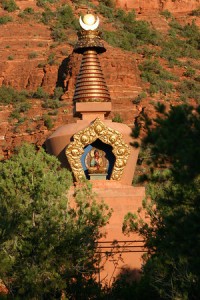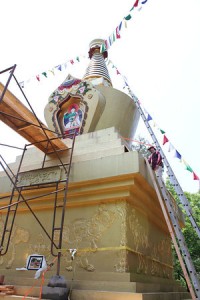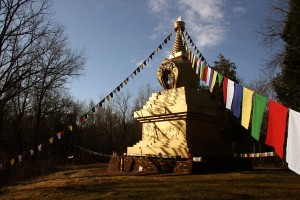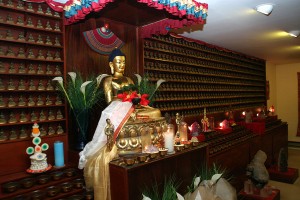The following is an excerpt from a teaching by Jetsunma Ahkon Lhamo called “The Lama Never Leaves”
I have seen amazing things. My own students do amazing things. When they weren’t healthy or when they weren’t fit they would do amazing things and they would benefit the stupa and create the causes for continued accomplishment. I’ve seen them do amazing things. I saw once one nun who was determined to get to one of my teachings. Her knees were so bad she couldn’t walk. I saw her crawling, crawling. And I immediately dedicated that merit to her swift enlightenment. And you know, I didn’t think to myself, “Oh, look at that, she’s crawling to see me.” I thought to myself, “Eh ma ho. How beautiful. How beautiful.”
So we have to stop thinking in such an ordinary way. We have to start thinking in the way of Dharma, in the way of practitioners. You can’t wear robes and live an ordinary life. You have to do for the sentient beings. You have to maintain this garden of refuge across the street for their sake as well as your own. You have to do for the Sangha. It’s just as much merit to do for the Sangha, to make offerings to the stupas, to make offerings to the Lamas. This is extraordinary. To make offerings even to the Sangha. I know the wonderful Chang family has been offering food for myself and also for the Sangha here. What a tremendous, tremendous gathering of virtue that is. What an awesome family. What values to teach your children. My goodness. What an extraordinary wealth to pass on to your young. Sure you could pass on a few dollars, but what is that? To pass on the wealth of how to be happy… My goodness.
Yet we just kind of trudge around in our habitual tendencies without seeing the beauty of it all, the wonder of it all—that here in this place lives Lord Buddha himself, Guru Rinpoche himself, without doubt in Nirmanakaya form, and we can always go to pray. You know, we might say, “Oh, I can’t practice right now, because my practice is not going very well.” Well, that’s when you practice. That’s when you crawl across the street to the stupa if you have to and you recite prayers to the stupa. You say, “Please, I’m begging you with tears in my eyes. Help me in my practice. Come to me as wisdom. Clear my self-absorption so that I can benefit sentient beings and before I die let me do something meaningful other than to hang out with my own distorted phenomena. Let me make this world a place with less suffering. Please, I’ll do anything.”
You lay down your pride, you lay down your thoughts, you lay down your body, you lay down your efforts, you lay down your offerings and you rise up a practitioner. The way of Dharma is to turn our minds from ordinary things—those things that are so relentlessly stupid as to take up all of our time and all of our effort and give us zero, zilch, nothing in return—and to pick up and accept and cherish that which is here for us, that which holds out its arms to us, like our own primordial mother, and says “Come, I’m here for you. Bring the others. I’m here.”
Do not turn a blind eye to these offerings that I and other lamas have given you. They are for you. These stupas, what we have here, is only for you. And so I ask you to accept once again. I ask you not to be beggars under the table lapping up crumbs, but to come to the feast. Come to the feast at last.
That’s our Dharma talk for today. I hope it is of some benefit to you. And I really sincerely mean for this to result in activity.
Let me make one more mention. We talk about creating the causes for bringing the lama back, so we maintain the house for the lama. If the lama has a habit of putting a wrap on their legs when they’re by their chair, the wrap should be by the chair. The lama’s slippers should be by his bed. The lama’s favorite cup should be out on the counter. The lama’s altar should be opened every day. If you really want to create the causes for the lama’s return, that’s how you do it. The lama never leaves.
When the lama is not here, the lama’s picture should be on the throne. And we should think like that. The lama has never left. And that’s our practice. That’s our guru yoga. And we have the visible means of support using the stupas that way as well.
Copyright © Jetsunma Ahkon Norbu Lhamo All rights reserved





